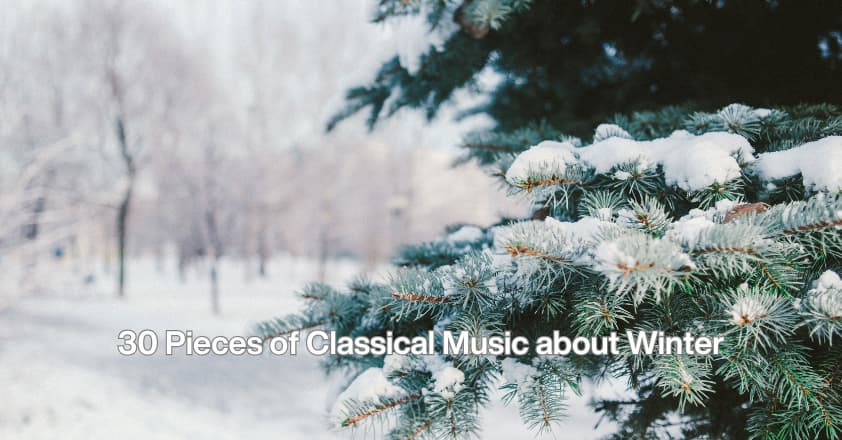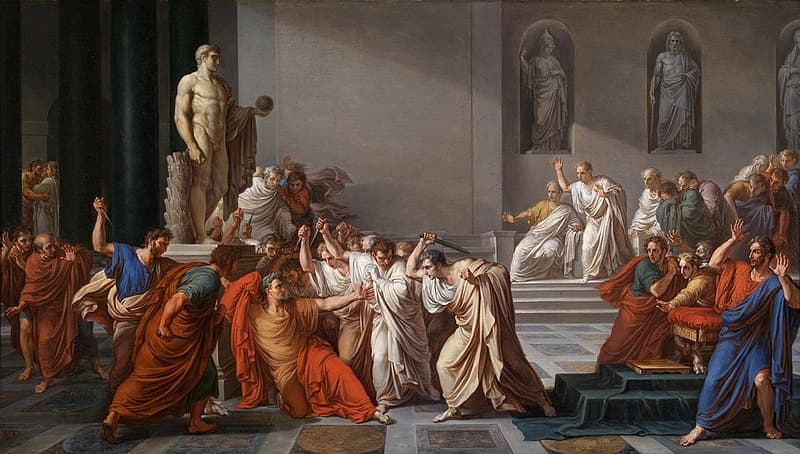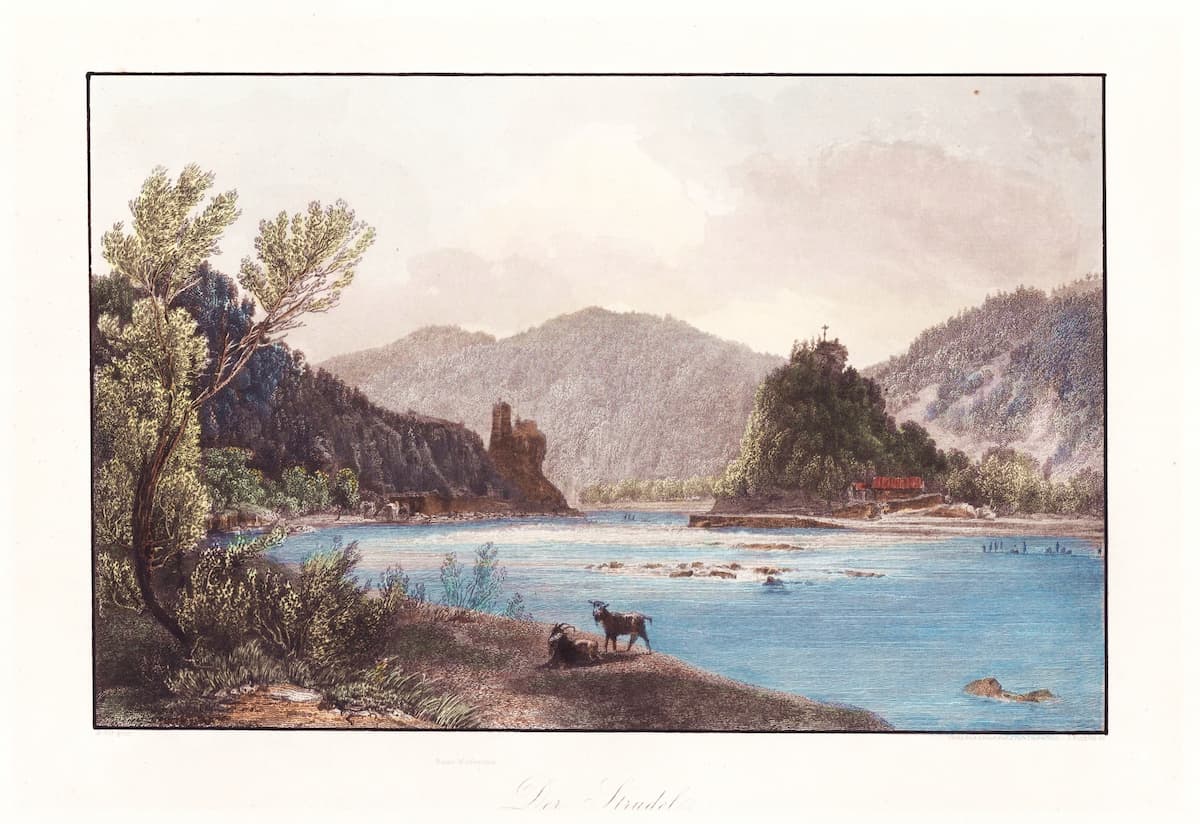Need some classical music about winter to add to your playlist?
Today’s your lucky day! Grab your scarf and your hot cocoa: we’re about to comb the last three hundred years of music history, looking for the best classical music about winter.

Henry Purcell: Now Winter Comes Slowly from The Fairy Queen (1692)
British composer Henry Purcell wrote the opera The Fairy Queen in 1692.
The Fairy Queen contains four pieces that describe each season. The last of these pieces is “Now Winter Comes Slowly”, which describes the gradual transition from autumn to winter.
Now winter comes slowly,
pale, meager and cold,
First trembling with age,
and then, quivering with cold…
Antonio Vivaldi: Winter from The Four Seasons (ca. 1720)
Around 1720, Italian composer Antonio Vivaldi wrote four violin concertos to depict each season. He included sonnets in the score that described in words what he was describing in music.
Winter’s sonnet included lines like this:
To tremble from cold in the icy snow,
In the harsh breath of a horrid wind;
To run, stamping one’s feet every moment,
Our teeth chattering in the extreme cold…
You can hear the musical representation of chattering teeth in the opening of this concerto.
Joseph Haydn: Winter from The Seasons (1801)
Joseph Haydn’s oratorio The Seasons features a detailed musical portrait of each of the four seasons.
The work’s libretto, or lyrics, describe a variety of wintry phenomena, including shorter days, frozen lakes, and a panicked wanderer lost in a blizzard. (Fortunately, said wanderer finds a warm, safe house to take shelter in!)
Franz Schubert: Winterreise (1827)
In his song cycle Winterreise (Winter Journey), Schubert set twenty-four poems by poet Wilhelm Müller about lost love.
In these poems, the narrator deals with the aftermath of his beloved falling in love with another man and the ensuing breakup. To escape the grips of his failed relationship, the narrator sets off on a dangerous, bitter journey in the snow.
Felix Mendelssohn: Winterlied from 6 Gesänge (1830-32)
Winterlied (“Winter Song”) is part of Mendelssohn’s 6 Gesänge (6 Songs), op. 19.
There are two narrators in this song: a worried mother begging her son to stay with her instead of venturing out into a dangerous snowstorm, and a son determined to brave the blizzard to find his lost sister.
In the end, the mother’s fears are justified: the son dies searching for his sister, leaving the mother alone.
Frédéric Chopin: Piano Etude Op. 25, No. 11 “Winter Wind” (1836)
After a simple, hymn-like start, Chopin’s “Winter Wind” etude explodes into a terrifying depiction of a blizzard.
A flurry of notes cascade in the right hand, calling to mind snowflakes being tossed about by the icy winter wind.
This is considered to be one of Chopin’s most difficult etudes.
Fanny Mendelssohn-Hensel: January from Das Jahr (1841)
Fanny Mendelssohn Hensel (the sister of composer Felix Mendelssohn) was a hugely talented composer and pianist.
In 1841, she decided to write a set of piano works, with each one inspired by a particular month. This collection is called Das Jahr, or The Year.
January’s piece is a breathless recollection of the distant glories of spring. Hensel included poetry in the score written by poet Johann Ludwig Uhland:
Can you again foresee, o soul,
The soft, sweet songs of spring?
Behold, all around, the fallow trees!
Ah, there were lovely dreams.
Robert Schumann: Winter Time from Album for the Young (1848)
Composer Robert Schumann wrote his Album für die Jugend, or Album for the Young, in 1848 as a gift for his children.
The collection consists of forty-three short, easy works for solo piano, perfect for young piano students. This little one is called “Winter Time.”
We wrote an article about what happened to the children this music was written for.
Pyotr Ilyich Tchaikovsky: Symphony No. 1, Winter Dreams (1866)
Tchaikovsky wrote his first symphony in 1866, the year he turned twenty-six. It is one of his first mature works.
He worked so hard on it that he became mentally and physically ill. At one point, his doctor claimed he was “one step away from insanity” due to overwork, and he was forced to take a break. That emotional intensity is certainly evident in the finished product.
Although not strictly programmatic, the first two movements have suggestive subtitles: “Dreams of a Winter Journey” and “Land of Desolation, Land of Mists.” Given this, it’s easy to picture any number of wintry narratives to go along with this music.
Johannes Brahms: Alto Rhapsody (fragment from Goethe’s “Winter Journey in the Hartz Mountains”) (1869)
As a young man, composer Johannes Brahms fell in love with pianist Clara Schumann, the wife of composer Robert Schumann.
After her husband Robert’s early death, Clara and Johannes chose not to pursue a romantic relationship for a variety of reasons.
However, years later, Johannes (who was thirteen years younger than Clara) developed feelings for Clara and Robert’s daughter, Julie.
After Julie married another man, Brahms wrote this melancholy Alto Rhapsody for contralto, male chorus, and orchestra.
He drew on lines from Goethe’s Harzreise im Winter, or Winter Journey in the Harz, which recounted the poet’s dangerous journey up the snowy Brocken peak in December 1777. This poetry – and its idea of love being like a dangerous winter journey up a mountain – captured some of his emotions during this time.
Franz Liszt: Christmas Tree Suite (1873-76)
Liszt dedicated this charming twelve-movement piano suite, known as the Christmas Tree Suite, to his first granddaughter, Daniela von Bülow, born in 1860.
The third movement is especially magical. It features a gentle fantasy on the well-known carol “Good Christian Men, Rejoice” (which starts at 8:19 in the video above).
Pyotr Ilyich Tchaikovsky: Winter Morning from The Children’s Album (1878)
The Children’s Album is a set of twenty-four simple piano pieces meant for children and consciously modeled after similar works by Schumann.
They were written for Tchaikovsky’s beloved seven-year-old nephew Vladimir (or Bob) Davydov. Tchaikovsky wrote to his brother-in-law: “Tell Bobik that the music has been printed with pictures, that the music was composed by Uncle Petya, and that on it is written Dedicated to Volodya Davydov. The silly little fellow will not understand what dedicated means… Even so, Bobik is an inimitably delightful figure when he’s playing, and he might look at the notes, and think that a whole symphony is dedicated to him.”
This particular selection from The Children’s Album portrays the poignant beauty of a winter morning.
Émile Waldteufel: The Ice Skaters (1882)
French composer Émile Waldteufel is remembered today as a bit of a one-hit wonder, courtesy of his classic waltz The Ice Skaters.
It was inspired by the composer watching skaters at a rink at the Bois de Boulogne in Paris.
One can practically see the little jumps (and maybe falls!) of the skaters, as well as the horse-drawn conveyances decorated with holiday bells pulling up to the rink.
Pyotr Ilyich Tchaikovsky: The Nutcracker (1892)
We had to include The Nutcracker! This ballet has become synonymous with winter and the holiday season, and for good reason.
Magical music accompanies the Christmas Eve adventures of Clara, the Nutcracker, the Sugar Plum Fairy, the Snow Flakes, the Mouse King, and other beloved characters.
Josef Suk: A Winter’s Tale (1894)
This thrilling overture from Josef Suk is inspired by Shakespeare’s play A Winter’s Tale.
We might be cheating a little bit by including it because in Shakespeare’s day, the phrase “a merry winter’s tale” didn’t literally mean “a story set in winter.”
Rather, it meant something more akin to what the phrase “old maid’s tale” means today: a story to be taken with a grain of salt that might be told around the fire on a cold winter day.
But this colorful, exuberant work is too charming not to include in our list!
Edward Elgar: The Snow (1895)
Elgar’s “The Snow” is an uncharacteristic work by a composer often known for his magisterial Britishness.
This is an understated piece for chorus, piano, and two solo violins. This instrumentation creates an unusual texture that really tugs at listeners’ heartstrings.
Adorably, the lyrics that Elgar chose to set were written by his poet wife, Caroline Alice Elgar.
Claude Debussy: “Yver vous n’estes qu’un vilain” from Trois Chansons de Charles d’Orleans (1898)
“Trois Chansons de Charles d’Orleans” (“Three Songs of Charles of Orléans”) are unique in Debussy’s output and his only work for a capella choir.
Charles of Orléans was a celebrated French poet who lived in the fifteenth century.
The third and final song in the collection is “Yver vous n’estes qu’un vilain” (“Winter, you are nothing but a rogue”).
The regal narrator scoffs at winter and compares it unfavorably with other seasons. “Winter, you exude / Snow, wind, rain and hail; / You ought to be exiled.”
Alexander Glazunov: Winter from The Seasons (1899)
In the 1899 ballet The Seasons, Alexander Glazunov portrays each of the four seasons in a series of four tableaux.
The ballet begins with a winter scene. In it, a dancer portraying winter is joined by others representing frost, ice, hail, and snow.
Ralph Vaughan Williams: The Winter’s Willow (1903)
In 1903, Ralph Vaughan Williams wrote a song called “The Winter’s Willow”, which describes a beautiful young rural woman (as the narrator says, “few winters had a-blow’d her hair”). The words are written in a Dorset dialect.
Ernest Bloch: Winter-Spring (1905)
Swiss composer Ernest Bloch’s two-movement orchestral work Winter-Spring devotes one movement to each season.
The bleak “Winter” movement feels desolate, deeply personal, and distinctly hopeless. That despair ultimately sets the stage for the contrast of the second movement that celebrates spring.
Béla Bartók: No. 38: Winter Solstice Song from For Children (1908-09)
Like Schumann and Tchaikovsky, Béla Bartók was inspired by the idea of writing collections of short solo piano pieces for children.
One of these collections was published as For Children. It features eighty-five short pieces for solo piano spread across four volumes (this was eventually compressed to two).
Bartók wrote a variety of brief descriptive pieces, including works with titles like “Children’s Game”, “Teasing”, and “Game of Tag.” The thirty-eighth piece in the collection celebrates the “Winter Solstice.”
Sergei Rachmaninoff: The Silver Sleigh Bells from The Bells (1913)
The Bells is a symphony for chorus and orchestra. Rachmaninoff believed it was one of the best things he ever wrote.
The words come from American poet and horror writer Edgar Allen Poe’s poem “The Bells.”
The poem begins by portraying the innocent “jingling and tinkling” silver bells of the winter season. (Later, more solemn bells – church bells at a funeral, perhaps? – ring with “melancholy menace.”)
Frank Bridge: Winter Pastorale (1925)
British composer Frank Bridge’s “Winter Pastorale” is a pensive work for solo piano. It perfectly captures the still, forbidding landscape of a cold winter morning.
Interestingly, Bridge ends “Winter Pastorale” with a decrescendo and five beats of rest, with a fermata on the final beat, thereby writing silence into the music.
Arnold Bax: Winter Legends (1929-30)
Composer Arnold Bax and pianist Harriet Cohen had an ongoing affair for decades.
During that time, they were not just romantic partners; they were creative partners, too, and Cohen premiered and championed many of his works.
Winter Legends is like a piano concerto: it’s for piano and orchestra and forty minutes long. Bax described it as “a northern nature piece full of sea and pine forest and dark legends.”
Sergei Prokofiev: Winter Bonfire (1950)
Winter Bonfire was written for Soviet state radio. It tells the story of a group of children on a celebratory winter trip out of Moscow.
Over the course of the work, the children board a train, waltz on the ice, and build an evening bonfire to keep warm…all activities that Prokofiev vividly depicts in his score.
John Rutter: Blow, blow thou winter winds (1975)
“Blow, blow thou winter winds” is a setting of a song from Act II of Shakespeare’s play As You Like It.
The lyrics compare a broken friendship to the winter wind. In the end, the narrator decides that the emotional pain of a friend forgetting about you is worse than the coldest winter days.
Morten Lauridsen: Mid-Winter Songs (1980)
When writing his Mid-Winter Songs, American composer Morten Lauridsen was inspired by the work of British author Robert Graves.
The work is five movements long. Strikingly, the main motifs of all five movements are played during the work’s introduction, which results in the songs possessing a special musical cohesiveness.
Max Richter: Winter from Vivaldi Recomposed (2012)
Vivaldi Recomposed is a work for violin and orchestra written by German-born British composer Max Richter in 2012.
The work originated after Richter thought about how overfamiliar many listeners are with Vivaldi’s omnipresent Four Seasons. He wanted to inspire listeners to hear these works in a new way.
So he decided to create a new work inspired by the Four Seasons, taking elements from the original concertos and combining them with new music. His hope was that after listening to the new version, musicians and audiences alike would hear Vivaldi’s original works with new ears.
Caroline Shaw: Winter Carol (ca 2013)
American composer Caroline Shaw was born in 1982. She started playing violin when she was two and composing when she was ten, and she won the Pulitzer Prize when she was thirty.
She is especially interested in writing music for voice, and often sings in performances of her own works.
Her “Winter Carol” simultaneously sounds centuries-old and completely modern. It creates a strange, mysterious mood that is perfect for a winter afternoon.
Michael Torke: Winter’s Tale (2014)
American composer Michael Torke wrote the five-movement Winter’s Tale in 2014 for cello and orchestra.
Torke’s own notes about the work read:
Though not based on Shakespeare’s The Winter’s Tale, the concerto is nevertheless inspired by lines from the play: from moody winter thoughts, through warmer and more redemptive springtime feelings. Each of the five movements is similar in structure, organized in a palindromic fast-medium-slow-medium-fast scheme, but each movement has its own melodies, harmonies, and effects. My ear was led by the melancholic yet singing richness of the solo cello’s sound.
Conclusion
As we’ve seen, there are dozens of works of classical music that evoke the myriad moods of winter.
From the melancholy of a Baroque-era opera to a modern-day cello concerto, composers have crafted centuries of options for listeners seeking out winter-inspired classical music to enjoy.
Happy listening!
For more of the best in classical music, sign up for our E-Newsletter


